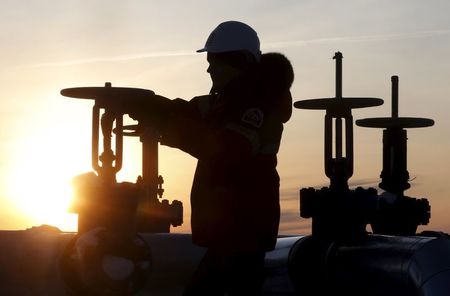Commodities
Oil prices to stay lower through 2025 amid global oversupply risk: Wells Fargo

Investing.com — Oil prices are expected to remain subdued through 2025 due to the elevated risk of global oversupply, as per analysts at Wells Fargo in a note dated Tuesday.
A combination of slowing demand from key economies, especially China, and the persistent growth of U.S. shale production are contributing to a bearish outlook on oil prices.
Despite tight current inventories, the anticipated easing of OPEC+ production cuts by the end of 2024 further supports the likelihood of a supply surplus into the next year.
Wells Fargo mentions that the oil market is at a tipping point, moving from supply tightness in 2024 to a potential oversupply by 2025.
Wells Fargo notes that both the U.S. and China, traditionally strong drivers of global oil demand, are showing signs of slowing growth. In the U.S., shale oil production has matured, and the rate of growth has decelerated despite continued output from the prolific Permian Basin.
On the demand side, China’s economic growth has moderated, reducing its appetite for oil, a key factor in global oil price trends.
In 2025, global oil supply is expected to exceed demand by about 1 million barrels per day (bpd) during peak production months.
This is partly due to the anticipated ramp-up of OPEC+ production, which had been restrained to stabilize prices.
Wells Fargo forecasts total oil supply to rise from 102.8 million bpd in 2024 to 104.8 million bpd in 2025, driven by non-OPEC producers such as the U.S. and Brazil, alongside OPEC’s planned increases.
Wells Fargo has adjusted its near- and medium-term oil price forecasts downward. The firm now expects to average $70 per barrel in 2025, a reduction from earlier estimates. Similarly, West Texas Intermediate (WTI) crude is forecast to average $65 per barrel in 2025.
This represents a drop from 2024’s second quarter average of $80 per barrel for Brent and $75.25 for WTI.
Although these price levels are lower than the highs seen in 2022, when Brent peaked at nearly $100 per barrel, they remain above levels experienced during historical demand slumps.
One of the critical factors keeping prices from plummeting further is Saudi Arabia’s preference for maintaining prices above $70 per barrel, as the kingdom seeks to balance revenue generation with maintaining market share.
Wells Fargo draws a comparison between the current oil market situation and the conditions of 1998, when a combination of a global economic slowdown and an influx of new supply led to a collapse in oil prices.
“We are not calling for a repeat of 1998 in 2025, but we fully comprehend investor angst given economic uncertainties in China and OPEC+’s stated desire to reverse its curtailments,” the analysts said.
Investor sentiment reflects this uncertainty. Speculative interest in crude oil futures has turned net negative, indicating that market participants expect further price weakness in the short term.
U.S. shale production, which has been a driver of global oil supply growth over the past decade, is showing signs of maturity. While the Permian Basin remains productive, overall U.S. oil production growth is slowing.
As of the third quarter 2024, U.S. oil output has grown by only 0.1 million bpd, compared to an average of 0.6 million bpd in previous growth years.
This fall is due to both resource maturity and a strategic shift by U.S. producers toward capital discipline, focusing on returns rather than production volume.
Despite the slowing growth in crude oil, the production of liquids continues to rise. NGL production has been increasing annually since 2009, and by 2024, it accounted for 56% of the growth in U.S. liquid production.
This shift towards NGLs, which are used in petrochemical production and other industries, indicates a broader transformation in the U.S. energy landscape, which could have long-term implications for both global supply and price stability.
Several factors could alter the current trajectory of oil prices. A faster-than-expected recovery in global demand, particularly from China and OECD countries, could tighten the market and push prices higher.
Additionally, geopolitical risks in oil-producing regions, such as the Middle East or Russia, could disrupt supply and lead to price spikes.
Commodities
Oil prices rise; U.S. crude inventories plunge, Russia-Ukraine truce eyed
Commodities
India’s Reliance to stop buying Venezuelan oil over US tariffs, sources say
Commodities
Oil prices climb on Venezuela supply worries

 Forex3 years ago
Forex3 years agoForex Today: the dollar is gaining strength amid gloomy sentiment at the start of the Fed’s week

 Forex3 years ago
Forex3 years agoUnbiased review of Pocket Option broker

 Forex3 years ago
Forex3 years agoDollar to pound sterling exchange rate today: Pound plummeted to its lowest since 1985

 Forex3 years ago
Forex3 years agoHow is the Australian dollar doing today?

 Cryptocurrency3 years ago
Cryptocurrency3 years agoWhat happened in the crypto market – current events today

 World3 years ago
World3 years agoWhy are modern video games an art form?

 Commodities3 years ago
Commodities3 years agoCopper continues to fall in price on expectations of lower demand in China

 Economy3 years ago
Economy3 years agoCrude oil tankers double in price due to EU anti-Russian sanctions























